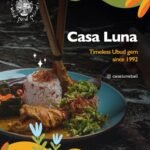My journey over the past few weeks has been celebrating the culinary goddesses of Ubud, the women who have helped shape Ubud’s identity as the centre of all things gastronomic. You can bury any illusions of the glamorous Nigella Lawson twin-set types. These Ubud women are salt-of-the-earth mothers and gracious in their own right, running their home-grown businesses from the heart.
So, I thought I would take you back to the early seventies again, to a time in Bali when tourists were few. My first visit to Bali was in 1974, when Ubud was an untamed jungle of sorts. But to glean more information about those idyllic years, I thought it best to chat with none other than my husband, Ketut: a proud Ubudian from his temple-scarfed head to his well spread toes. In fact, in writing this column I am rather reluctant to depart from these long-gone days. How lovely they were!
So sit down and cross your legs as I continue a tale of life in Ubud thirty years ago, (you might want to put the kettle on too!) and join me as I honour the women who remain but faded memories in the minds of my husband’s generation and beyond.
Drumroll and enter: Jero Made Munir, otherwise known as Nini Meneer. Nini Meneer was one of Ubud’s most famous food sellers in the seventies. Born and bred in Ubud, she hailed from the Gusti Homestay compound in Jalan Kajeng and her claim to culinary fame was Lawar sampi or beef lawar and beef satay. Lawar is one of Bali’s beloved ceremonial dishes that is a powerhouse of everything the animal ever owned, mixed with lashings of chilli, coconut and shrimp paste. It can be made with any meat and often incorporates various exotic vegetables and leaves. With the leftover scraps of beef, Nini Meneer lovingly created serapah satay or Balinese-style satay of pounded meat wrapped onto thick bamboo sticks and grilled.
Each day in the afternoon, when the sun was slowly descending and losing its bite, Nini Meneer would appear with her rustic table perched on her head piled with all her edibles, walking to the market or wherever there was a bit of village action to sell her famous lawar and satay. Sometimes she would even walk as far as Peliatan, a distance of around three kilometres. You could say she was a moveable feast.
But ‘village action’ I hear you ask. Remember this was the early seventies before the box of ill repute, the television, had infiltrated Bali and one of the most popular past-times, apart from temple gatherings, was cock-fighting. Of course, cock-fighting was performed mainly when there were ceremonies, give or take a few other hundred days of the year. In fact, when I first visited Ubud, cock-fighting was held every afternoon at the Ubud Wantilan or community hall.
So picture the crowded scene: layers of men surrounding a small arena of fighting roosters, gambling their rupiah away in a Lord-of-the-Flies type fervour, chanting the wild cock-fight call, amidst a veil of clove cigarettes; for those were the days when most Indonesian males smoked profusely. And picture little Nini Meneer seated quietly at her table in the corner of the hall, towel on her head, selling her home-cooked treats to a hungry crowd. Hers was a thriving business. My husband, Ketut, a teenager at the time, remembers it vividly. And when Nini Meneer was not at the cock-fights, she was selling at the market or temple ceremonies all around Ubud. She was as regular as clockwork.
I chatted to Ketut about Nini Meneer. Have you ever spoken to a Balinese about the old days? Have you seen the wistfulness and softness in their eyes? Ketut re-called this tiny grandma, wandering down the memory lane of his mind into a charming place when life was less complicated. “Life was easier then” he said, “maybe, in a sense, it was better than now. There were no real pressures, just ceremonies and simple food”.
Nini Meneer was a typical Balinese grandma: small as Balinese grandmas are, with long hair that was smeared with fresh coconut oil and coiled up on the head. Ketut recalled Nini Meneer’s lawar. “It really was delicious” he reminisced. “But the trouble was, Nini Meneer liked to chew on beetle nut. She chewed it slowly until it dribbled out of the corner of her mouth while she was mixing the ingredients. And as we stood there waiting to buy her food, we would all watch the trickle of red juice, as it ran from her mouth and down to her chin. We watched and watched and prayed it would not run into the lawar”.
“And was there anything distinctive about Nini Meneer’s clothing?’ I asked, trying to establish if she had a certain look. “Did she wear a particular type of kebaya?” I asked. In those days, bold polyester florals were all the rage so I wondered if she had a well-worn favourite, maybe splashed with motifs of big red roses or polka dots that she wore as a trademark. ‘Yes. She wore a kebaya” Ketut replied, “But actually only half the time. The rest of the time she was she bare-breasted!”
Ketut and I decided to drop into Nini Meneer’s home to chat to her son, Gusti Ketut Bajra, who lives behind Puteri Salon in Jalan Kajeng, to gain a little more insight into this legendary culinary diva. Have you ever wandered up this street? It has a lovely village atmosphere and is overflowing with small homestays and warungs. This is the North Ubud banjar territory of which I am a member. Banjars are rather like extended families, so this street is where I often go to attend weddings and family ceremonies.
As we gazed at a few family photos, I was surprised to find out that Nini Meneer is the mother of Gusti Putu Roni who is often seated out the front of temple ceremonies in Ubud, renting a pile of sarongs to eager tourists. Do you know her? She is rather eccentric and sells jackfruit on the ground floor of the Ubud market, in the far-eastern corner. She always makes me laugh.
Gusti Ketut Bajra is now 66 and said his mother started selling lawar well before he was born. He is one of eight brothers and sisters. “Your mother had a thriving business then?” I asked. “It was a good business but we were poor in those days,” he said. And looking at Ketut, added, “We were all poor then. You don’t know this about the life then, do you Ketut?” (Ketut being nearly twenty years younger )
“We didn’t have an inheritance, didn’t own any rice fields and before the fifties, we didn’t always have rice to eat. Sometimes people just ate vegetables. These were the crisis years for us. But we had enough to eat.”
I watched Gusti as he spoke and could see the movement in his eyes, as if I was rekindling a slow-burning fire. “I remember there used to be around ten people who helped my mother prepare the satay. They would sit on the ground and make the bamboo sticks. When their job was finished, we would give them one satay and some lawar for their efforts. That was their payment. Others would just get meat stock. There were ten coconut bowls and we would fill each one with the stock of plain boiled meat. That was all. We hadn’t even added the spices yet, because spices were expensive in those days.”
Gusti was in charge of buying the meat for his mother. Every day, he would walk to the make shift abattoir in Tenggkulak, about five kilometres away, to buy the fresh meat. He would then walk home, with the meat straddled across a bamboo pole on his shoulders, via the rice fields and Monkey Forest. It was called survival!
“Do you have Nini Meneer’s lawar recipe” I asked (that is one recipe I would have insisted I learn, I thought). “Heaven’s no,” he said and chuckled. “We never thought of asking her for it”. Gusti then proceeded to tell us that, even though Nini Meneer used the same ingredients as everyone else to make her lawar, the same gingers and spices, there was something about the process, the way she mixed it, that created such a luscious end result.
Sometimes Nini Meneer would barter her lawar for offering cakes at the temple or swap coffee from the farmers in exchange for rice. “But this was not really good,” said Gusti, “because then we would not have cash to buy meat for the lawar!”
“But, you know” he continued, “beef was more delicious then too. Even if you ate it without spices. The cows were fed on grass, nothing else. They were not pushed as they are nowadays and there were no feeds or chemicals used.” I watched that wistful look on all their faces: two men from two generations, remembering days gone by.
When Nini Meneer died in 1992 she was possibly ninety years old. “She was hardly ever sick and she never really said much,” said Gusti. But the legacy she left in the hearts of the people of Ubud remains. All you have to say is, “do you remember Nini Meneer,” to the older folk of Ubud, and you will see their eyes light up. Thus is the power of food.






